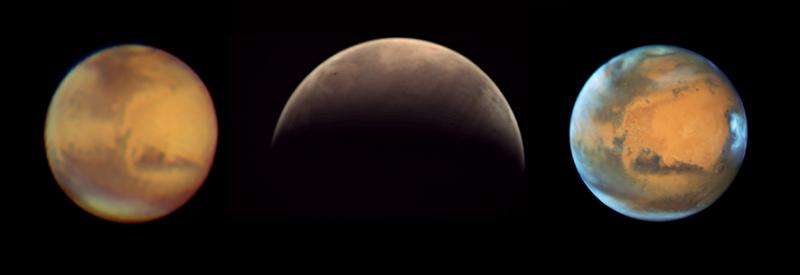Image: Mars triptych

This triptych brings together three excellent images of Mars acquired this month by two cameras in space and one in Australia.
The image at left was taken on 22 May by amateur astrophotographer Dylan O'Donnell from his home-built backyard observatory in Byron Bay, New South Wales. On 22 May, Mars was at opposition with respect to Earth, meaning the Sun and Mars were on exact opposite sides of Earth. Mars was also rather nearby, at just 76.3 million km from Earth. To capture his image, he used a Celestron 9.25 inch Edge HD telescope. In a Facebook posting, Dylan noted:
Mars is at opposition tonight, which means its brighter than it will be for another few years, and it's one of the larger views for many years. Previously I thought the white at the bottom was the southern polar ice cap but a recent Hubble image reveals this is persistent cloud cover. Indeed much of the cloud cover from 12 May seen in the Hubble image, on the right, can still be seen in mine on 22 May.
The image at right is the ESA/NASA Hubble space telescope image that Dylan used for comparison with his own photo, and was acquired on 12 May (just 10 days before the opposition described above) when the planet was 80 million km from Earth, revealing details as small as 32–48 km across.
The image at centre was acquired by the Visual Monitoring Camera on Mars Express about 10 000 kms from the surface at 22:17 GMT on 22 May, some eight hours after Dylan conducted his observation.
With its operational usage having been completed in 2003, the low-resolution camera has until now been used for only outreach and education. Starting this spring, however, it has been upgraded to a full science instrument in recognition of the intrinsic quality of its images, which in particular can support cloud tracking and dust storm monitoring, making significant contributions to planetary science.
On 30 May, Mars will be the closest it has been to Earth in 11 years, at a distance of 75.3 million km. Mars is especially photogenic during opposition because it can be seen fully illuminated by the Sun as viewed from Earth.
Provided by European Space Agency





















